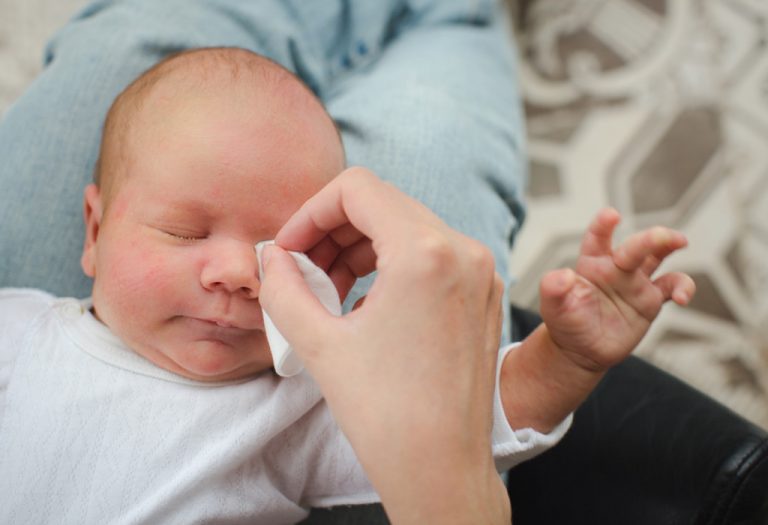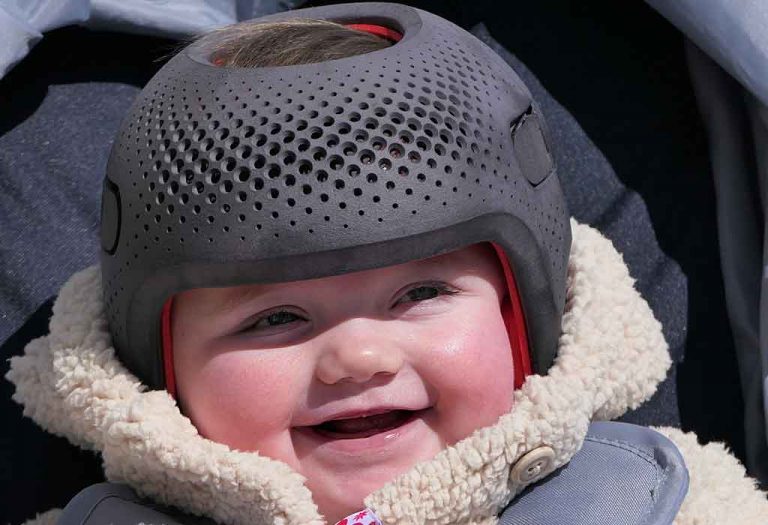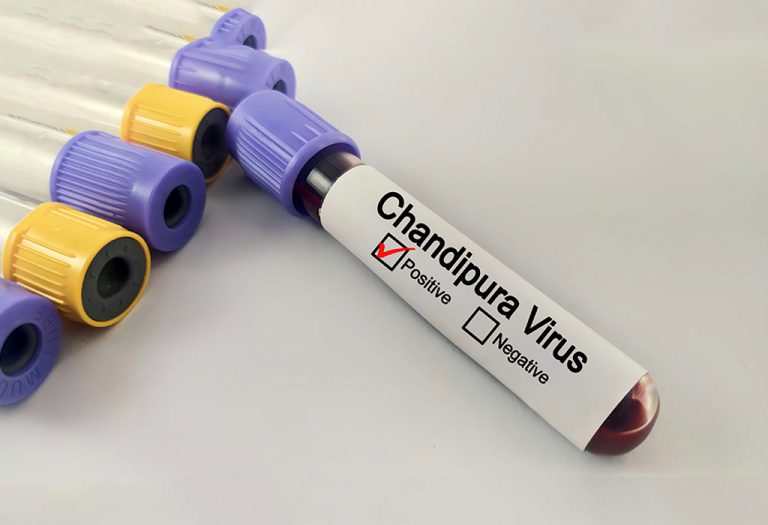Blocked Tear Duct in Babies – Causes, Symptoms & Treatment

From yellow discharge to eye infections, a blocked tear duct is one such condition that causes discomfort to babies and worry to parents. But is it life-threatening? No, blocked tear ducts are common among babies. In fact, about 20 per cent of babies are born with a blocked tear duct, as per the American Academy of Ophthalmology (1). Tears cannot drain properly when the duct is blocked, and the duct ends up swollen or infected. Most blocked tear ducts in babies resolve on their own, while others improve with treatment. Keep reading to learn more about how to soothe a blocked tear duct baby.
What Is a Blocked Tear Duct?
A blocked tear duct is a condition in which the tear duct (where tears drain through a small tube in the eyes) gets blocked or doesn’t open up properly. As per the Cleveland Clinic, these blockages stop or slow the flow of tear fluid, leading to a buildup in the tear duct system and into the affected eye. The clinical term for this condition is “nasolacrimal duct obstruction.” (2) Blocked tear ducts usually reveal themselves during the first two weeks after the baby is born, when the baby starts getting “watery” eyes. A yellow or white discharge often accompanies them, and sometimes this discharge ends up sealing the eyelids shut, too. You may also notice crusts on the eyelids and eyelashes (3).
How Common Is Blocked Tear Duct in Babies?
Almost six out of 100 newborns are affected by blocked tear ducts after birth. They may occur during the baby’s birth year and may not cause any eye problems when they first appear as well.
Causes of Blocked Tear Duct in Infants
The common causes of a blocked tear duct in infants are:
- When the tissue at the end of the tear duct is not able to open up
- Eye infections
- When the nasal bone grows abnormally, it puts pressure on the tear duct and seals it off
- Partial or underdeveloped openings near the corners of the eyes, where the tears drain out (4)
Signs and Symptoms of Baby’s Blocked Tear Duct
Symptoms of a blocked tear duct usually appear during the first few days to weeks after being born. Take a look at these commonly observed newborn blocked tear duct symptoms (5) (6):
- Yellow or white discharge from the corners of the eyes
- Redness and swelling of the eyes
- Watery eyes
- Tears streaming down the cheek
- Epiphora (excessive tearing)
- Tenderness or a bump near the side of the nose
- Swollen blue bump near the inside corner of the eyes (also known as dacryocystocele)
- Eye infections accompanied by fever, mucus or pus in the eyes
Diagnosis and Tests of Blocked Tear Ducts in Babies
Most blocked tear duct conditions in babies resolve naturally with time. However, sometimes a little bit of testing and diagnosis never hurts to cross-check if it stems from underlying causes. The Mayo Clinic suggests the following tests for diagnosing a blocked tear duct (7):
- Tear Drainage Test – A special dye is applied to your child’s eyes to check whether or not tears drain correctly. If the duct has anything that is blocking its path, then the dye remains on the eye’s surface even after five minutes pass.
- X-Ray Exam – An X-ray or CT scan of the dacryocystogram (tear duct area) is done to check for blocked tear ducts. It is followed up with an MRI to image the location of the blockage and identify its causes.
- Medical Evaluation – Your doctor may evaluate your medical history to ascertain whether tear duct blockages run in the family. A physical examination and an ophthalmic examination are done to check for other plausible reasons for blockage.
How to Treat a Blocked Tear Duct in Infants
Blocked tear ducts usually open up on their own. Meanwhile, here are four treatments you can try to help them open up and get those tears draining (8).
- Surgical Probing – Surgical probing is a procedure done at the hospital to manually open up the tear ducts through surgery. The procedure involves the ophthalmologist gently passing a thin metal probe through the tear duct to clear the blockage. Aftewards, they flush the tear duct with sterile water to clear the pathway. It’s done on an outpatient basis, and your ophthalmologist will recommend it if your baby has a severe infection and must be admitted to the hospital. The procedure lasts for about 10 minutes.
- Silicone Tube Intubation – Silicon tubes are inserted into the tear ducts to stretch and open them up. The tubes are kept in place for six months and surgically removed afterwards.
- Balloon Catheter Dilation (DCP) – A balloon is placed into the tear duct by insertion through the corner of the eye and inflated using a sterile solution to expand the tear duct openings. It is afterwards deflated and removed from the eyes.
- Antibiotic Eye Drops – If an infection spreads, your baby’s paediatrician may prescribe your little one some antibiotic eye drops or eye ointment. These drops or ointments aid in clearing up infections and eliminating harmful bacteria from blocked tear ducts.
Home Remedies for Baby’s Blocked Tear Duct
Home remedies work just as well as surgical treatment. Try these before you consider surgical procedures for your little one-
- Breast Milk – Apply a few drops of breast milk to treat blocked tear ducts in your little one’s eyes and watch them recover gradually.
- Tear Duct Massage – Ask your doctor to demonstrate how to do a massage to help your baby’s blocked tear duct, and be gentle. Basically, you apply gentle pressure between the tear ducts along the upper nose area to aid in clearing up the ducts. This can be done. The American Academy of Ophthalmology suggests massaging up to two times a day—morning and evening—every day. Each massage stroke should be ten strokes and can be done best during a diaper change (9).
- Warm Compress – Take a soft, clean washcloth and dip it in warm water. Gently wipe the insides of the duct and work your way outward so that particles don’t enter the eye. If both of your baby’s ducts are blocked, you must use another clean washcloth or a cotton ball to repeat the process.
Prevention of Newborn Blocked Tear Duct
Prevention is better than cure. Here are some ways you can prevent your baby’s tear duct from facing blockage in the first place-
- Wash your hands – Before and after cleaning their eyes, make sure to wash your hands and maintain hygiene.
- Massage regularly – You don’t need to massage your baby’s tear ducts only when there’s a blocked tear duct. By massaging from the start, you’ll prevent those tear ducts from clogging beforehand.
- Environmental factors – Reduce exposure to sunlight, cold, and wind for your infant to prevent tear duct blockage.
- Wipe their eyes – Use small cotton balls or a clean cloth to wipe away any excess drainage from your baby’s eyes regularly, especially the outer parts.
When to Call the Doctor
The American Optometric Association suggests a proper eye examination of all babies at 6 months of age, even when no issues seem to appear (10). If you notice any discomfort in your baby’s eyes, it is advisable to see a doctor right away. In case of blocked tear ducts in infants, a doctor’s consultation can help figure out any possible health infections that can cause your baby further discomfort and reduce the risk of infection.
FAQs
1. When do babies start having blocked tear ducts?
Blocked tear duct symptoms begin developing early and usually present themselves when the baby is three months old or before (11).
2. Can blocked tear ducts in newborn babies cause eye infections?
Yes, blocked tear ducts can lead to eye infections in newborn babies. Many babies are born with one or both of their tear ducts either blocked or partially blocked. This may lead to conjunctivitis with yellow or white discharge.
3. Can blocked tear ducts affect vision in babies?
No, blocked tear ducts usually don’t affect the vision in babies. However, eye checkups at regular intervals are important to address and treat any underlying eye conditions in babies.
4. Can breast milk help treat blocked tear ducts in babies?
There are several stories from some mothers that state the effectiveness of breast milk in treating a blocked tear duct. However, there’s no conclusive scientific evidence. Several mothers have shared their success stories by applying a few drops of expressed breast milk and softly massaging it onto their baby’s closed eyelid. The specific way it works is not clearly defined, but the antibacterial features of breast milk and its possible role in decreasing inflammation may help open up the tear ducts.
A blocked tear duct is nothing serious or extreme to worry about. It happens to many babies, and the above remedies will certainly come in handy. Try these out and watch them heal soon!
References/Resources:
1. American Academy of Ophthalmology – What Is a Blocked Tear Duct?
2. Cleveland Clinic – Blocked Tear Duct (Nasolacrimal Duct Obstruction)
3. Nationwide Children’s – Eye: Tear Duct Massage
4. Boston Children’s Hospital – Blocked Tear Duct (Dacryostenosis)
5. American Academy of Pediatrics – Tear Duct – Blocked
7. Mayo Clinic – Blocked tear duct
8. Nemours KidsHealth – Surgery for Tear Duct Blockage
9. American Academy of Ophthalmology – Blocked Tear Duct Treatment
10. American Optometric Association – Infant Vision: Birth to 24 Months of Age
Also Read:
Sticky Eyes in Newborn Babies
Dark Circles Under Baby’s Eyes
Baby Eyes Rolling Back – Is It Normal?
Baby Eye Color: When Does it Change and More
Was This Article Helpful?
Parenting is a huge responsibility, for you as a caregiver, but also for us as a parenting content platform. We understand that and take our responsibility of creating credible content seriously. FirstCry Parenting articles are written and published only after extensive research using factually sound references to deliver quality content that is accurate, validated by experts, and completely reliable. To understand how we go about creating content that is credible, read our editorial policy here.
























